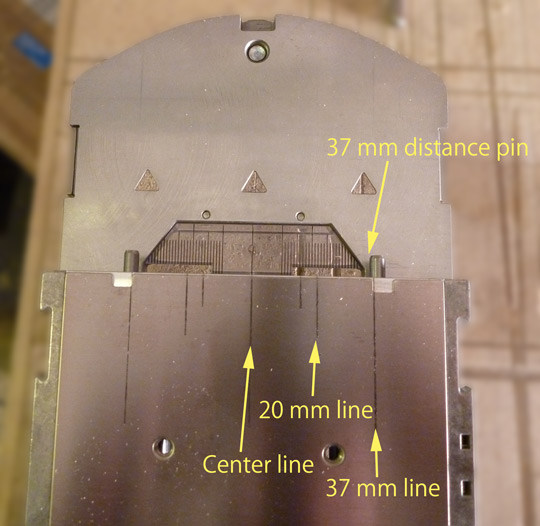Festool Domino is very useful also for non Domino joinery
The Festool Domino is a very fantastic invention. It can be used as intended, but it also has a lot of other usages that are often overlooked. The machine is high quality. The settings can be finely tuned. Thus it is a mortiser with a very good reliable and repetitive result.
 One of the sometimes overlooked side usages is that it can be used to make mortises for ordinary "non Domino" tennons. This is easy to do, since it can be easily tuned. It is easiest to achieve if you base mesaurements on the middle of the mortise, and know some base facts about the Festool Domino measurements.
One of the sometimes overlooked side usages is that it can be used to make mortises for ordinary "non Domino" tennons. This is easy to do, since it can be easily tuned. It is easiest to achieve if you base mesaurements on the middle of the mortise, and know some base facts about the Festool Domino measurements.
Aligning mortise to center of the thickness
Mortises are easily aligned with the center of the board thickness, since there is a built in middle height setting for many thicknesses. For boards with other thicknesses than the predefined, the Festool Domino height setting can be tuned about as easy as an ordinary router or mortising jig. Think in terms of height from the surface to the center of the mortise, and the setting becomes easier to tune.
- The Domino mortise can be even better centered in height, by making the mortises from both surfaces (as is the recommendation for all mortises where this is possible). This assures a perfectly centered mortise. This is especially good to do if using manual height settings on the Domino.
Tuning the width of the mortise
The width of the Festool Domino mortise can be tuned in three different predefined steps:
- Narrow setting: router bit diameter plus 13.7 mm
- Middle setting: router bit diameter plus 19.2 mm
- Wide setting: router bit diameter plus 23.2 mm
If the widths above are not close enough to the needed width, the Domino can easily be moved sideways to extend the mortise widht. In fact, this is so eas that I often find myself mortising with the Domino in narrow mode, and then doing two quick extras to the side. This gives me often av oversize of around 2 mm total, which is enough and more precise than the first widening step.
Setting the Mortise Depth
- Achieving wanted depth is the trickiest thing for the Festool Domino if the predefiend settings are not adequate. Preset depths are 12, 15, 20, 25, 28 mm (10 mm less in all steps if the bit used is the newer 4 mm router). These length settings may or may not be what you need. Easiest method to overcome the problem of the lengths, are as always using a template that limits the movement of the router (place the template between the Domino router and the piece worked on).
Placing the mortise at the right position and with wanted width
First of all, know the widths which are produced by the three width settings above. Also know the two reference measurements seen on the pciture above.
- From center to the inside of the pins i 37 mm.
- With the new base plate which was introduced with the new 4 mm router, the two retractable side stops align with the 20 mm line.
Thus, placing Domino mortise center 20 or 37 mm from something are the two most easily achieved settings. To do that, just align with either the pin, or the stop on the new base plate.
For other distance measurements, there is a number of well marked guides sold by Festool with the Domino.
Set the widestpredefiend Domino width which is smaller than or equal to the desired width, and route a mortise in the center of the wanted location. If the width is too small, then move the Domino suitable distance to both sides of the center, producing the wanted width.
Holding the Domino Horisontal and stable
 An important thing to remember is to utilise the full width of the adjustable board on the Domino to achieve vertical alignment. As seen on the picture, when doing mortises in narrow frames (here 45 mm), best advice is to place another piece of wood with the same thickness under the Domino base plate to be able to hold it stable and as horisontal to the frame surface as possible.
An important thing to remember is to utilise the full width of the adjustable board on the Domino to achieve vertical alignment. As seen on the picture, when doing mortises in narrow frames (here 45 mm), best advice is to place another piece of wood with the same thickness under the Domino base plate to be able to hold it stable and as horisontal to the frame surface as possible.
Use a good vacuum cleaner with the Domino
Probably one of the most important parts of making the Domino do a good cut is to use it connected to a vacuum cleaner. Without the vacuum, it will not cut as nice and clean, due to too much resistance from untranspoirted debris. There is a distinct feeling of vibration without a vacuum cleaner connected.






